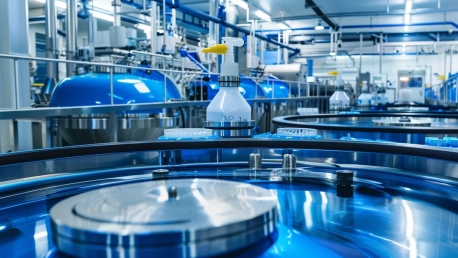Biopharmaceuticals are in a critical transition phase where the mission to provide high-quality, effective drugs is increasingly converging with the demand for environmentally sustainable production methods. This balance requires the adoption of innovative technologies under the Industry 5.0 framework, emphasizing a human-centric approach with AI and automation at the forefront. The shifts in production methodologies not only aim at maintaining efficacy but also focus on reducing the environmental footprint, which is imperative for long-term global health impacts.
The Dual Objective: High Quality and Sustainability
Biopharmaceutical companies are tasked with the dual objectives of ensuring drug efficacy and achieving net-zero emissions. According to research conducted by the Sargent Centre for Process Systems Engineering at Imperial College London, sustainable biopharma production is a complex challenge, with difficulties arising in the quantification of process sustainability. However, new digital tools are aiding in accurately assessing environmental impact, providing a pathway toward greener practices.
Challenges in Quantifying Sustainability
One of the prominent challenges is the product-specific nature of processes. This variation complicates efforts to distinguish more sustainable products, as processes differ significantly between companies. According to Miriam Sarkis, a doctoral student and lead author of the study, distinguishing more sustainable products is challenging because each process is tailored to specific products and operational frameworks. Despite these obstacles, existing model-based tools from other industries show potential for application within biopharma, indicating a growing momentum for cross-industry comparative studies.The difficulty in quantifying process sustainability has been a major hindrance in the industry’s efforts to become more eco-efficient. With each company adopting its proprietary methods tailored to unique product lines, a standardized metric for sustainability remains elusive. Nevertheless, tools designed for other sectors can serve as a useful reference point. These tools can be adapted and refined for biopharma, providing a more granular understanding of environmental impacts across different production pathways. This can pave the way for a broader evaluation of sustainable practices within the industry, serving as a foundation for future regulatory frameworks and policy guidelines.
Water Consumption and Material Use
Upstream processes in biopharma are notably water-intensive, primarily due to cell cultivation requirements. Downstream processes complicate sustainability further through the need for copious resins and solvents. The study pinpoints that traditional stainless steel equipment exacerbates water demands for sterilization and cleaning between batches. Conversely, the switch to single-use equipment helps mitigate water usage, offering increased manufacturing flexibility and scalability.Compounding the issue is the substantial use of materials like resins and solvents in downstream processes, adding layers of complexity to sustainability efforts. Utilizing stainless steel equipment, while reliable, necessitates frequent sterilization and extensive cleaning procedures, further escalating water consumption. The transition to single-use technologies has demonstrated promise in countering these sustainability challenges. Single-use systems require comparatively lesser water for sanitation between batches, facilitating not just ecological benefits but also agility in production lines. This change has profound implications for scaling operations efficiently, particularly for manufacturers aiming to rapidly respond to fluctuating market demands.
Continuous Manufacturing: A Sustainable Shift
Emerging trends in biopharmaceutical manufacturing emphasize the industry’s move towards continuous manufacturing, driven by both economic and environmental incentives. Continuous processes reduce the cost and environmental footprint per unit of product and highlight a significant paradigm shift in production methodologies. This shift aligns with sustainability goals, offering advantages such as reduced waste and energy consumption, which are critical for achieving eco-efficiency.
Economic and Environmental Benefits
Continuous manufacturing significantly lowers operational costs while reducing the environmental impact of production. This shift aligns with sustainability goals, offering advantages such as reduced waste and energy consumption, which are critical for achieving eco-efficiency. The economic benefits are evident in the form of more streamlined operations, translating to lower production costs and improved efficiency.The environmental advantages, on the other hand, are underscored by a smaller carbon footprint and a reduction in resource consumption. By minimizing waste generation and energy usage, continuous manufacturing processes contribute to a more sustainable production cycle. This is vital for the industry, which is under increasing pressure to adhere to stringent environmental regulations while maintaining high standards of drug quality. The convergence of economic and ecological benefits renders continuous manufacturing an attractive pathway for future biopharma operations.
Regulatory and Technical Hurdles
However, the transition to continuous manufacturing is met with technical and regulatory challenges. Current regulatory frameworks demand bespoke control strategies that ensure process and product quality. The development of comprehensive end-to-end control strategies remains a significant hurdle, necessitating innovations in automation and AI to streamline the transition. Cleo Kontoravdi, PhD, highlights that regulators require manufacturers to develop specific control systems to consistently monitor processes and maintain product quality throughout the continuous manufacturing cycle.These bespoke strategies are essential in mitigating risks associated with continuous processing, ensuring that quality control parameters are met consistently. However, the development and validation of such control systems are complex and time-consuming, posing a significant challenge for the industry. Additionally, the lack of universal guidelines complicates the regulatory approval process, necessitating a more collaborative approach between industry stakeholders and regulatory bodies. Overcoming these hurdles is paramount for the wider adoption of continuous manufacturing, which holds promise not just for sustainability but also for the future resilience of biopharmaceutical production.
Automation and AI: Driving Efficiency and Quality
Automation and AI technologies are essential for improving process efficiency in biopharma, aligning with the industry’s quality, economic, and environmental goals. These technologies offer benefits such as enhanced process control, reduced variability, and cost savings. The adoption of AI-driven automation empowers manufacturers to achieve higher consistency and precision in bioprocesses, crucial for maintaining stringent quality standards.
Model-Predictive Control Solutions
Model-predictive control (MPC) solutions are integral to advanced bioprocess control but are currently process-specific. The biopharma market lacks generic, user-friendly MPC options essential for integrating upstream and downstream processes. This gap indicates a growing need for automated, AI-driven technologies to enable robust process performance. These technologies not only facilitate better control but also offer predictive insights, enabling preemptive actions to rectify potential issues before they escalate.The integration of model-predictive control mechanisms can revolutionize how biopharmaceuticals are produced. This advancement is instrumental in enhancing real-time decision-making capabilities, thereby optimizing overall process efficiency. Yet, the existing model-based control solutions are heavily customized to specific processes, limiting their broader applicability. Developing more generic and adaptable MPC systems would address a critical market need, offering scalable solutions that can be universally adopted across various biopharma operations. This innovation promises to foster more seamless integration of upstream and downstream processes, driving the industry towards more holistic and sustainable production methodologies.
Improving Process Efficiency
AI and automation enhance process efficiency by providing better control and consistency. These technologies support the industry’s drive towards innovative bioprocessing methods, ensuring sustainable manufacturing while maintaining high product quality. Automated bioprocessing offers numerous advantages, including improved process control, enhanced product quality, reduced variability, increased efficiency, and cost savings.By leveraging AI algorithms, manufacturers can achieve a higher degree of precision and scalability in production processes. The predictive capabilities of AI systems enable proactive maintenance and optimization of the production line, minimizing downtime and enhancing throughput. These advancements are pivotal in meeting the dual objectives of sustainability and high-quality drug production. As the industry continues to evolve, the integration of AI and automation is expected to play an even more significant role in shaping the future of biopharma manufacturing, driving towards more intelligent, efficient, and sustainable practices.
The Rise of Single-Use Technologies
Single-use technologies are becoming increasingly popular within biopharma manufacturing, providing benefits such as lower water usage, improved facility flexibility, and scalability. These technologies are crucial in supporting the industry’s sustainability goals, offering a viable alternative to traditional stainless steel equipment. The shift to single-use systems presents a paradigm shift that aligns well with both operational and environmental objectives.
Reducing Environmental Impact
Single-use systems reduce the need for extensive cleaning and sterilization, thereby lowering water and energy consumption. They offer a more flexible, adaptable manufacturing setup that can easily scale up or down based on demand, contributing to sustainability objectives. By minimizing the need for rigorous cleaning protocols, single-use technologies significantly decrease resource utilization, aligning with the goal of reducing the environmental footprint of biopharmaceutical manufacturing.The move towards single-use systems also offers economic advantages by reducing operational costs associated with sterilization and maintenance. This cost-effectiveness, coupled with the environmental benefits, renders single-use technologies an attractive option for biopharma companies aiming to enhance sustainability. These systems facilitate a more streamlined production process, enabling rapid shifts in production scales and offering greater adaptability to changing market demands. As such, single-use technologies are poised to play a crucial role in the future landscape of biopharma manufacturing, supporting the industry’s sustainable evolution.
Enhancing Flexibility and Scalability
With single-use technologies, biopharma companies can achieve greater flexibility in their manufacturing processes. These systems are easier to configure and reconfigure, allowing for rapid adjustments in response to changing market demands and production needs. The inherent modularity of single-use systems facilitates swift transitions between different production scales, fostering an agile manufacturing environment capable of promptly responding to therapeutic demands.Moreover, the scalability offered by single-use systems is instrumental in accommodating varying production volumes without significant adjustments to the existing infrastructure. This flexibility not only supports sustainability efforts but also enhances operational efficiency, enabling manufacturers to optimize their production workflows. As the industry continues to prioritize sustainability, the adoption of single-use technologies is expected to surge, driven by their numerous advantages in promoting eco-efficient and adaptable manufacturing practices.
Conclusion
Biopharmaceuticals are undergoing a significant transition where the goal of delivering high-quality, effective medications increasingly intersects with the need for sustainable environmental practices. This evolution necessitates the integration of cutting-edge technologies within the Industry 5.0 framework, which prioritizes a human-centric approach while leveraging AI and automation. The transformation in production methodologies not only ensures the continued efficacy of drugs but also aims to minimize environmental impact, essential for the health of our planet and future generations.Additionally, as the field advances, researchers and manufacturers are focusing on sustainable practices that include energy-efficient processes, reduction of waste, and the use of eco-friendly materials. This holistic approach is not only beneficial for the environment but also aligns with regulatory requirements and consumer expectations for greener products. Ultimately, these shifts are pivotal for maintaining the delicate balance between advancing medical science and safeguarding the planet, ensuring that the pharmaceutical industry contributes positively to global health and sustainability targets.









